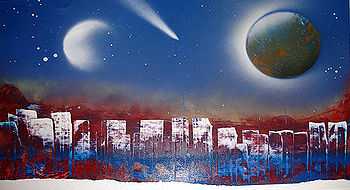Spray paint art

Spray paint art is an art form using spray paint, traditionally on posterboard, but can be done on any non-porous material, such as wood, metal, glass, ceramic or plastic. It differs from graffiti art in that the name is the central theme in graffiti and it is predominantly performed on buildings, trains and rail property the like, as opposed to more traditional art surfaces.
Background
| Graffiti |
|---|
|
| WikiProject Graffiti |
Spray paint art is a unique form of art that is generally performed on the street in large metropolitan cities. Typically, it features surreal landscapes of planets, comets, pyramids, cities, and nature scenes. The pieces can have a simple one-colored background or a multi-colored backgrounds in which the paint swirls together or fades from one color to the other through a series of differing values of each color.
One story behind the start of this art form (also known as Aerosolgrafia or Sadotgrafia by its founders) is that it originated in Mexico City in the early 1980s as described in the article "Spray-paint artists have exploded onto the scene - but is it art?" (Knight Ridder/Tribune News Service Article date: December 8, 2003 Author: Robinson, Gaile Copyright COPYRIGHT 1999 Knight-Ridder/Tribune News Service) Ruben “Sadot” Fernandez first painted (experimentally in public) in front of his studio but soon moved to the streets of La Zona Rosa (1982) and began attracting crowds. Sitting in a lotus position surrounded by aerosol cans he created human figures and faces, and natural landscapes on paper, cardboard, or canvas. He did not use a brush. Sadot wrote poetry, made mosaics, and did art in a number of traditional art media, but became most renowned for his work with aerosol spray paint. An important aspect of this art form is the music that often accompanies the performance. This inspires the artist and is an integral part of the experience for the spectator. Sadot listened to classical music, rock, and pre-Hispanic Aztec beats while painting. He often shocked those watching with his strong opinions on politics and government, and mystified the crowd with his metaphysical observations of culture and the human condition. Though Sadot was the first, many followed his lead venturing into the world of Aerosolgrafia. Due to the ready availability of the minimal tools necessary, how quick a work could be produced, and the possibility of making good money at it, others soon tried their hand at this art form.
Other artists have acknowledged the founder as Frank Frazetta in the 1960s.
Substrate
The artist usually paints onto high gloss surfaces, or semi to non-porous surfaces including photo paper, canvas and high quality poster board. This artwork however has and can be done on almost any surface. As such it is possible to find pieces of artwork in this style on anything from glass to skateboards and hoods of cars.
Tools
- Spray paint
- Oil painter's palette knife. Each artist choosing from a variety of shapes and sizes.
- Glossy magazine pages - used to remove paint in a random fashion from the canvas creating texture.
- Bowls, buckets, lids, cans or other circular objects - used as stencils for creating planets by covering a texture from paint which is applied afterwards to form a background.
- Respirator - rated for organic vapors to prevent inhalation of toxic fumes. Paper masks similar to those worn by surgeons are not sufficient and provide very little, if any, protection to the user against the many harmful chemicals in aerosol propelled paint.
- Paper towels, (sea) sponges, plastic grocery bags, straight-edge, inside-out tube socks and countless other items can be utilized to manipulate or apply the paint in a variety of ways to create different textures. Basically, any tools other than those associated with traditional oil painting (mainly brushes) are "acceptable" among puritans of this historically nontraditional medium.
Process
The artist will start by creating a mental layout of how they want their picture to be painted. One needs to know where specific details will be placed, including but not limited to planets, trees, mountains, stars, haze, and water, in order to layer the colors appropriately and in the right areas. The process is similar to painting backwards; the artist must lay the paint for the painting's foreground objects first.
The technique involves a series of well placed layers and textures and predetermined blocking and masking using the lids, bowls and recycled objects.
The artist can also add ambient effects by using a painter’s spatula, a window scraper, or a straight edge. Sometimes the best tool is to simply use one’s fingers. This process takes time and practice, but, like any learned art form, can become second nature to the artist.
References
See also
- Aerosol paint
- Airbrush
- Graffiti
- Stencil Graffiti